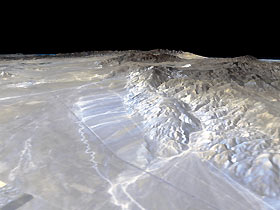
Save this image free of charge
in 800 pixels for layout use
(right click, Save as...)
|
|
Ref : V01893
Theme :
Looking at Earth - Faults (69 images)
Title : Perspective View, Garlock Fault
Caption :
California's Garlock Fault, marking the northwestern boundary of the Mojave Desert, lies at the foot of the mountains, running from the lower right to the top center of this image, which was created with data from NASA's Shuttle Radar Topography Mission (SRTM), flown in February 2000. The data will be used by geologists studying fault dynamics and landforms resulting from active tectonics. These mountains are the southern end of the Sierra Nevada and the prominent canyon emerging at the lower right is Lone Tree Canyon. In the distance, the San Gabriel Mountains cut across from the left side of the image. At their base lies the San Andreas Fault which meets the Garlock Fault near the left edge at Tejon Pass. The dark linear feature running from lower right to upper left is State Highway 14 leading from the town of Mojave in the distance to Inyokern and the Owens Valley in the north. The lighter parallel lines are dirt roads related to power lines and the Los Angeles Aqueduct which run along the base of the mountains.This type of display adds the important dimension of elevation to the study of land use and environmental processes as observed in satellite images. The perspective view was created by draping a Landsat satellite image over an SRTM elevation model. Topography is exaggerated 1.5 times vertically. Elevation data used in this image was acquired by the Shuttle Radar Topography Mission (SRTM) aboard the Space Shuttle Endeavour, launched on February 11, 2000. SRTM used the same radar instrument that comprised the Spaceborne Imaging Radar-C/X-Band Synthetic Aperture Radar (SIR-C/X-SAR) that flew twice on the Space Shuttle Endeavour in 1994. SRTM was designed to collect three-dimensional measurements of the Earth's surface. To collect the 3-D data, engineers added a 60-meter-long (200-foot) mast, installed additional C-band and X-band antennas, and improved tracking and navigation devices. The mission is a cooperative project between the National Aeronautics and Space Administration (NASA), the National Imagery and Mapping Agency (NIMA) of the U.S. Department of Defense (DoD), and the German and Italian space agencies. It is managed by NASA's Jet Propulsion Laboratory, Pasadena, CA, for NASA's Earth Science Enterprise, Washington, DC.Size: Varies in a perspective view Location: 35.25 deg. North lat., 118.05 deg. West lon.Orientation: Looking southwest Original Data Resolution: SRTM and Landsat: 30 meters (99 feet) Date Acquired: February 16, 2000
|
|

